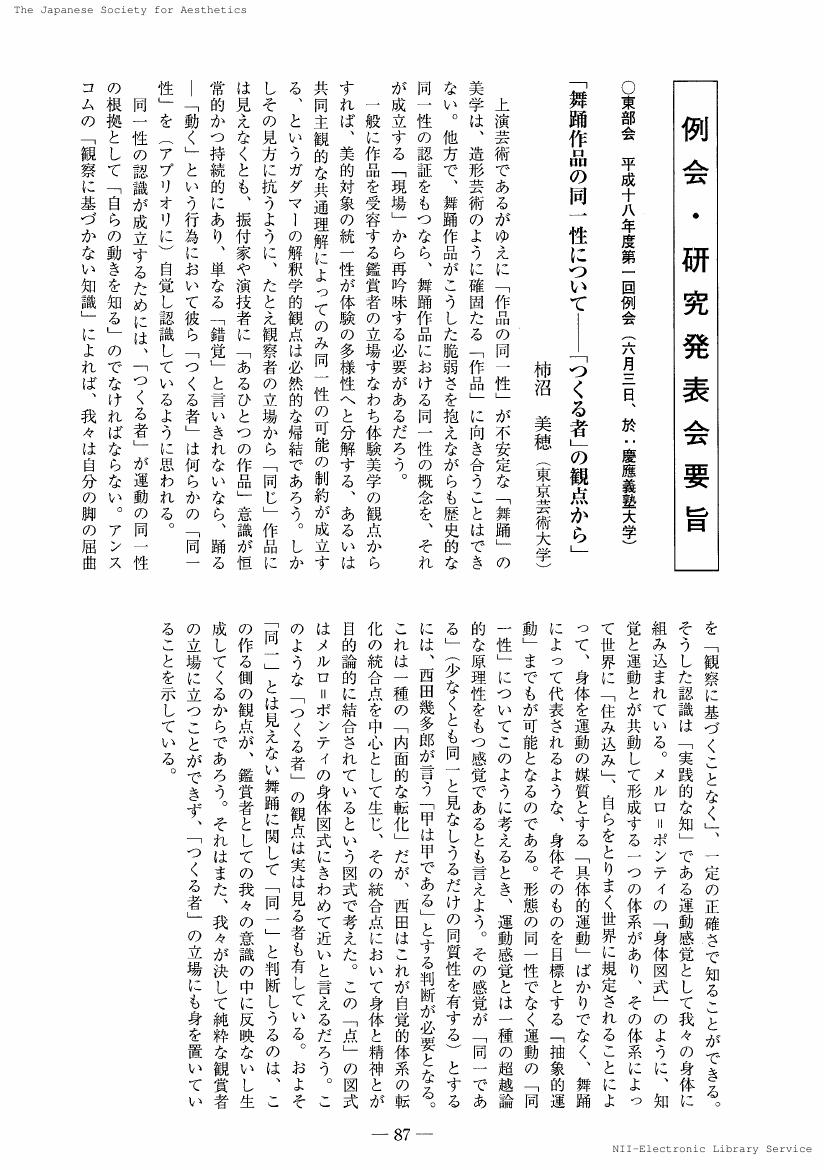1 0 0 0 OA 人間における言語とmovementの関係 ダンスの指導事例の比較検討とその考察
- 著者
- 柿沼 美穂
- 出版者
- 日本メルロ=ポンティ・サークル
- 雑誌
- メルロ=ポンティ研究 (ISSN:18845479)
- 巻号頁・発行日
- vol.23, pp.1-21, 2020-01-31 (Released:2020-02-04)
- 参考文献数
- 13
It is not so easy to choose appropriate words for our physical knowledge about human movement, so called, kinesthesia, or convert it into adequate data. We often have difficulty transmitting or sharing such information. However, we are faced with the necessity to do so in various scenes of life, for example, in the classes of physical education at school, or in some occupations requiring the high-level skills inherited from our predecessors. Then, we try to clear a hurdle with some special verbal expression to evoke our kinesthesia or dynamic sense of movement. In this research, I take up two representative ways of describing our dynamic sense of movement, namely, the linguistic expression of movement quality: “The Languages of Craft (Waza-Gengo)” proposed by Kumiko Ikuta as well as Rudolf Laban’s “effort.” And through the comparative study of contemporary dance class using those two linguistic expression, I discuss how they make different influence directly on our body movements, especially on its qualitative aspects. The discussion is based on the linguistic theory and “schéma corporel” of Merleau-Ponty. Thus the research leads the more effective communications of our physical knowledge with words, and hopefully sheds some light on the problem of the relationship between mind and body.
1 0 0 0 OA 身体と言語の関係について 人間のmovementと言語に関する 実験に基づく考察
- 著者
- 柿沼 美穂
- 出版者
- 美学会
- 雑誌
- 美学 (ISSN:05200962)
- 巻号頁・発行日
- vol.69, no.2, pp.71, 2018 (Released:2020-03-23)
1 0 0 0 OA 身体と言語 道感の質的記述の試みから見えてくるもの
- 著者
- 柿沼 美穂
- 出版者
- 美学会
- 雑誌
- 美学 (ISSN:05200962)
- 巻号頁・発行日
- vol.67, no.2, pp.87, 2016 (Released:2018-01-01)
- 著者
- 柿沼 美穂
- 出版者
- 美学会
- 雑誌
- 美学 (ISSN:05200962)
- 巻号頁・発行日
- vol.64, no.2, pp.122, 2013-12-31 (Released:2017-05-22)
- 著者
- 柿沼 美穂
- 出版者
- 美学会
- 雑誌
- 美学 (ISSN:05200962)
- 巻号頁・発行日
- vol.57, no.2, pp.87, 2006-09-30 (Released:2017-05-22)



